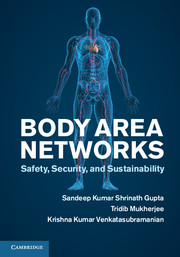Book contents
5 - Security
Published online by Cambridge University Press: 05 April 2013
Summary
In this chapter, we focus on security for BANs. In particular, we present a new paradigm that uses environment coupling – a property inherent to BANs – for this purpose. However, before we delve into the details, we provide some general concepts and definitions pertaining to the notion of security, which we use throughout this chapter. Though the notion of security has many connotations, for the purposes of this book, we define it in the information-security context, as preventing unauthorized entities from viewing, accessing, or modifying data generated within a system. We use the term system in a generic sense to mean a computing system that takes an input, processes it, and provides an output.
In order to ensure information security within any system, five basic requirements need to be satisfied. (1) Data integrity ensures that all information generated and exchanged during the system's operation is accurate and complete without any alterations. (2) Data confidentiality ensures that all sensitive information generated within the system is disclosed only to those who are supposed to see it. (3) Authentication ensures that the system knows the identities of all the entities interacting with it, and vice versa. (4) Authorization ensures that any entity trying to access particular information from the system is able to access only that information to which it is entitled. (5) Availability ensures that any entity that uses the data and services and resources of the system is able to do so when required.
- Type
- Chapter
- Information
- Body Area NetworksSafety, Security, and Sustainability, pp. 63 - 83Publisher: Cambridge University PressPrint publication year: 2013



